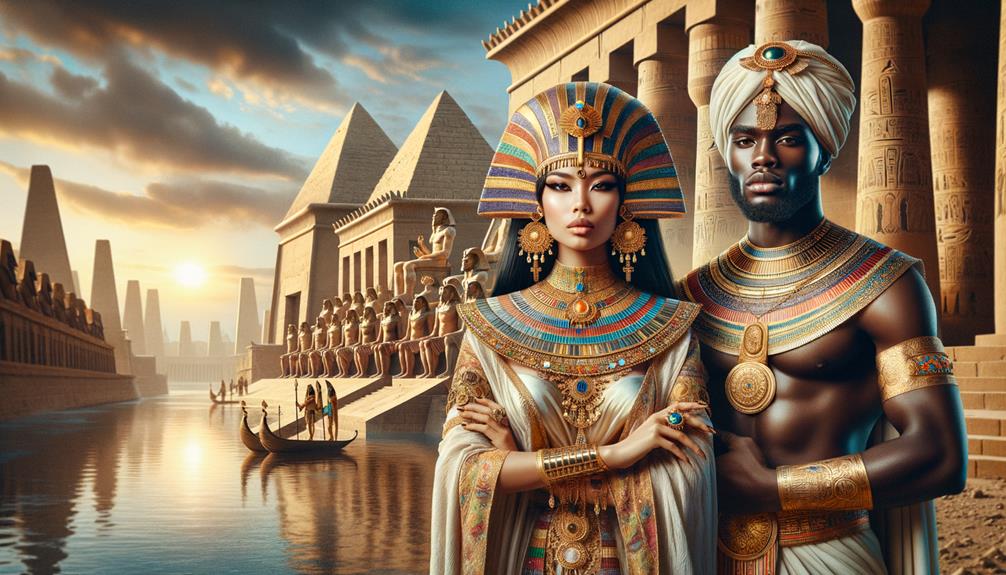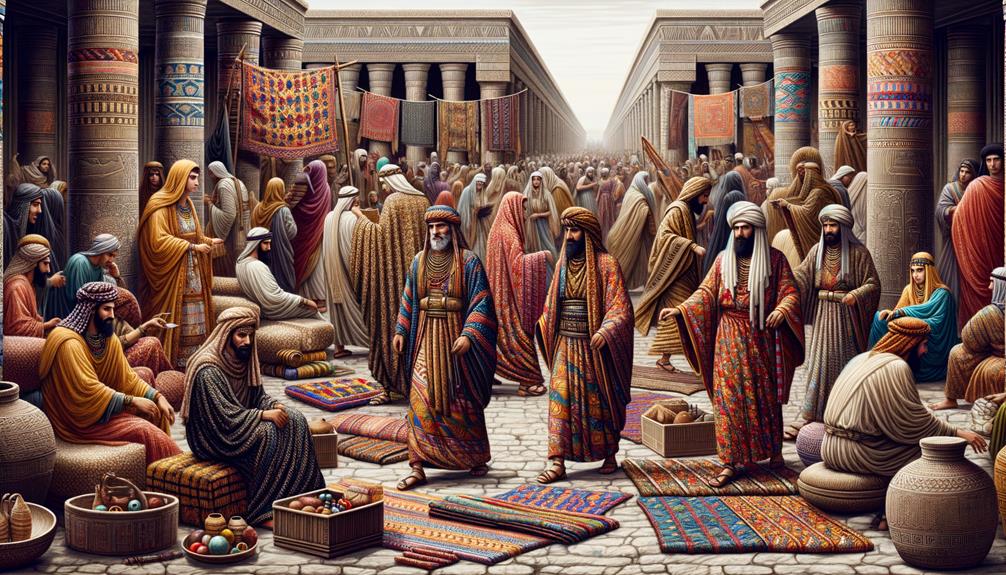I was struck by a painting of a Maya noble draped in vibrant, intricately woven textiles, and it resonated deeply with me. The Maya didn't just wear clothes; they expressed their identity, beliefs, and place in the universe through their attire. They transformed cotton fibers and natural dyes into garments that conveyed their complex social hierarchy. Each piece, adorned with feathers and jewels, was a reflection of their sophisticated society. What fascinates me most is how these textiles were more than just fashion – they told a story of their own. What secrets do these ancient threads hold?
Importance of Textiles
In Maya society, textiles were more than just clothing – they were powerful symbols of social status and religious significance. The intricate designs and vibrant colors tell a story of wealth, power, and divine favor. Clothing wasn't just practical, it was a canvas for expressing one's place in society.
Women played a vital role in this cultural tapestry as primary weavers. They wove not just threads, but stories and symbols that resonated with the community's spiritual and social fabric. Each piece of textile, from the simplest garment to the most elaborate ceremonial attire, reflected the wearer's position in society. It's as if each thread told a part of the grand narrative of Maya life.
The tradition of Maya weaving, dating back to between 1000-800 BC, highlights the deep significance of textiles. These ancient artisans crafted identities and preserved social hierarchies. When I think about how these women contributed to this time-honored tradition, I realize their work wasn't just about clothing – it was about sustaining a culture's essence and values through the art of weaving.
Textile Production Techniques
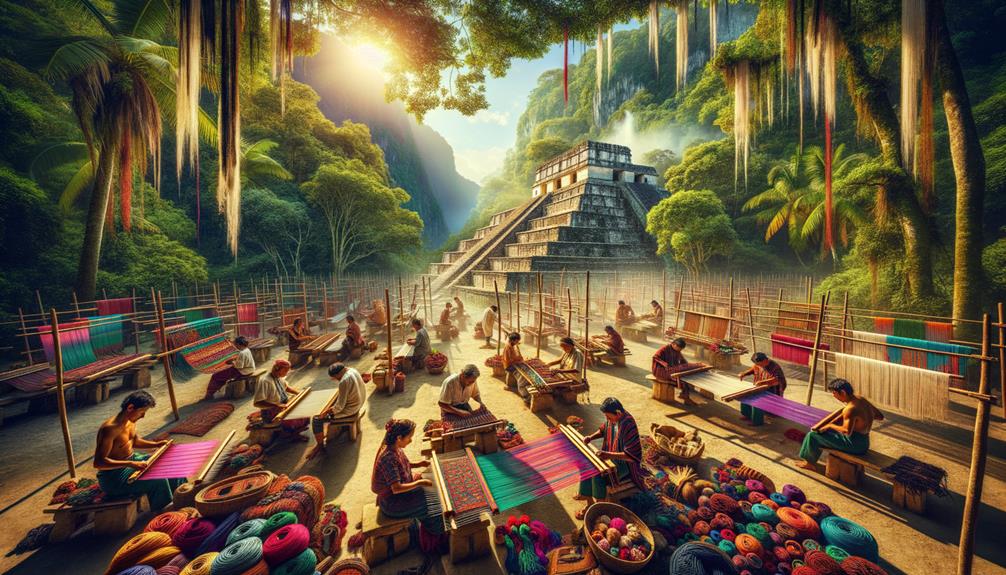
When I think about Maya textile production, I envision the meticulous process from raw materials to finished fabric. The Maya people carefully cleaned and spun cotton, then dyed it using natural sources like insects and plants. Observing their weaving methods and decorative patterns, I see a profound connection to their cultural identity and social hierarchy.
Materials and Dye Sources
The Maya's mastery of textile production, evident in their use of versatile cotton fibers and vibrant natural dyes, reflects their deep connection to the resources around them. By observing the Maya's thorough approach to textile production, it's clear they had an intimate knowledge of natural materials. They chose cotton fibers for their availability and adaptability, forming the backbone of Maya textiles.
The dyes they employed were incredibly resourceful. They drew from a rich palette of natural sources, extracting vivid reds from cochineal insects, deep purples from molluscs, and striking blues from the indigo plant. These colors weren't just about aesthetics; they signified status, identity, and cultural symbolism. Wealthier women took their textiles to the next level, embellishing them with feathers and pearl beads, transforming functional garments into works of art.
Their textile production process, dating back to 1000-800 BC, was meticulous. It began with cleaning and spinning cotton fibers, followed by the application of these natural dyes, and culminated in the creation of elaborate tapestries. This ancient craftsmanship, blending functionality with artistry, underscores a legacy of innovation and tradition that inspires contemporary textile artisans today.
Weaving Methods Employed
Observing the Maya's detailed approach to dyeing, I'm struck by their intricate weaving methods, which transformed spun cotton into elaborate, vibrant textiles. The process began with cleaning and spinning cotton into threads, a meticulous task performed by skilled hands. What fascinates me most is their use of the backstrap loom, a device that allowed weavers to create remarkably complex tapestries. This loom was more than just a tool; it was an extension of the weaver's body, tethered around the back and anchored to a fixed point, giving precise control over tension and pattern.
The woven tapestries weren't mere fabrics but vivid narratives, often reflecting the Maya creation story. Each piece told a tale, rich with cultural symbolism and artistic expression. The dexterity required to manipulate threads into such detailed designs speaks volumes about their innovative spirit. Women, the primary weavers, infused their work with spiritual significance, often incorporating materials like feathers and pearl beads for the wealthier classes.
Their techniques represented a profound connection between art and life. Every thread spun into these textiles was imbued with tradition, making Maya weaving a true expression of human ingenuity.
Decorative Patterns Used
Diving into the decorative patterns used by the ancient Maya, I'm struck by their ability to weave complex geometric designs, animal motifs, and mythological symbols into their textiles. Skilled artisans using backstrap looms created intricate patterns that tell stories of their culture and beliefs. They employed advanced techniques like brocade, tapestry weaving, and supplementary weft to achieve these detailed designs.
Textile artisans didn't just stop at weaving; they meticulously added embroidered details, enhancing the visual and tactile richness of their fabrics. Natural dyes, derived from indigo, cochineal insects, and various plants, added vibrant, long-lasting colors to their creations. These dyes didn't just color the textiles – they transformed them into vivid narratives and status symbols.
Moreover, the incorporation of feathers, shells, and precious stones into the textiles wasn't merely decorative; it showcased the Maya's profound artistic skills and cultural symbolism. Each pattern and embellishment was a deliberate choice, reflecting their relationship with nature, mythology, and social hierarchy. Through weaving and embroidery, the Maya crafted more than just textiles – they created cultural artifacts that continue to inspire and intrigue us today.
Everyday Garments
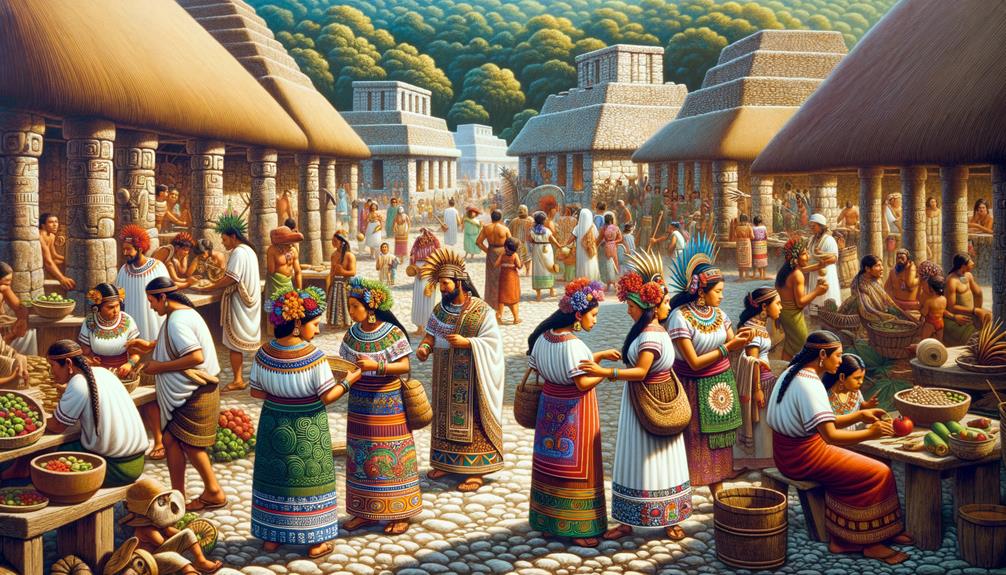
Here's a rewritten version of the text:
When I imagine the everyday clothes of the ancient Maya, I picture men in simple loincloths and sleeveless cotton shirts, while women wore huipils or trajes adorned with intricate designs. Sandals and moccasins were practical and distinct footwear options. These clothing choices, along with braided hairstyles, not only offered comfort but also subtly conveyed social status and gender roles.
Common Fabrics Used
The Ancient Maya crafted their everyday garments from locally sourced materials, each chosen for its unique properties and practical benefits. Cotton, with its softness and versatility, became a staple for weaving. I can imagine the skill required to spin and weave cotton into fabric, a process that demanded patience and expertise. Agave fibers, on the other hand, provided a coarser texture suitable for more utilitarian purposes, showcasing the Maya's resourcefulness in utilizing readily available resources.
Bark cloth, primarily reserved for ceremonial attire, also found its place in daily wear. The process of creating bark cloth was equally fascinating, involving soaking and beating the bark until it transformed into a pliable material. It's intriguing to think about how these traditional methods persisted through generations, reflecting a deep connection to their environment and culture.
These fabrics weren't just functional; they were an expression of the Maya's resourcefulness and aesthetic values. Each piece of clothing told a story of the land and the people who meticulously crafted them, blending practicality and artistry in a way that continues to inspire.
Typical Clothing Items
Observing the everyday attire of the Ancient Maya, I'm struck by how their clothing seamlessly blended practicality with artistic expression. Typically, Maya men wore loincloths paired with sleeveless cotton shirts. Women, on the other hand, often wore huipils or trajes, cinched with elaborate sashes. Both men and women wore sandals, a reflection of their need for comfort and mobility in their environment.
The intricate designs and vibrant patterns woven into their garments weren't just for aesthetics; they showcased the sophisticated artistry of Maya weavers. Each piece of clothing was a canvas that displayed the skill and creativity of the weavers. It's fascinating to imagine the time and effort that went into creating these everyday masterpieces.
The meticulously crafted patterns evoke a sense of reverence for their art. The use of shell ornaments and quetzal feathers speaks to their connection with nature. The practicality of sandals underscores their attentiveness to daily needs. Long braids in women's hair add a layer of cultural significance to their attire.
In essence, the typical clothing items of the Ancient Maya were a beautiful blend of functionality and art, reflecting their rich cultural heritage.
Gender-Based Attire
Examining the everyday garments of the Ancient Maya, I notice how clothing choices were distinctly influenced by gender roles and societal expectations. Men in Maya society typically wore loincloths, sleeveless cotton shirts, and capes. These garments were practical for the warm climate and the labor-intensive tasks men often undertook. The simplicity of men's daily wear reflected their roles within the community, allowing for ease of movement and comfort.
Women, on the other hand, wore huipils or trajes adorned with intricate designs, often adding sashes to accentuate their attire. These garments were not just functional but also a canvas for artistic expression, showcasing their skilled weaving techniques. The elaborate patterns on women's clothing highlighted their societal status and cultural identity. Long hair styled in braids complemented their daily wear, adding an element of elegance and continuity to their appearance.
Both men and women wore sandals, although farmers preferred moccasins for their durability during tough labor. Footwear, much like the clothing, was a subtle indicator of one's role and status within Maya society. Through their daily wear, the Ancient Maya skillfully balanced practicality with cultural significance, creating a distinct and innovative sartorial legacy.
Elite Attire and Regalia
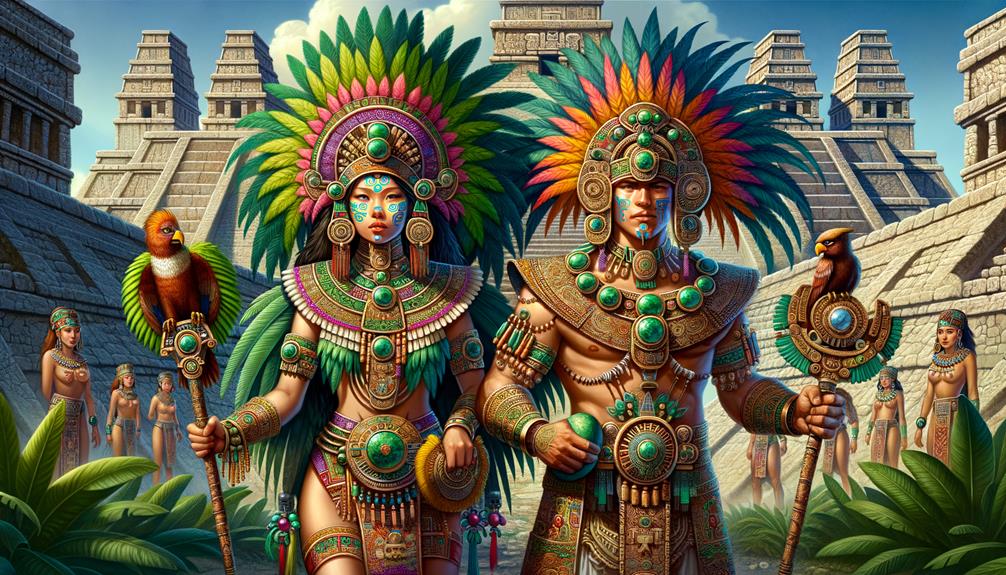
Elite Maya attire, adorned with vibrant feathers, precious jewels, and intricate designs, boldly conveyed the immense power and status of the elite within Maya society. Observing the rich symbolism in their clothing, I marvel at the meticulous craftsmanship and profound meanings these garments carried. The elite Maya didn't dress simply to impress; their regalia was a potent display of authority, abundance, and cultural significance.
One striking piece was the beaded maize god skirt, worn by elite individuals to signify fertility and prosperity. The detailed work and precious materials used in their attire were clear indicators of their wealth and social ranking. The clothing and regalia were more than just adornments; they were statements of who they were and the power they wielded.
Consider the emotional impact of their attire:
Feathers represented the divine and the ethereal.
Jewels embodied wealth, power, and exclusivity.
The maize god skirt symbolized life and sustenance.
Intricate designs showcased artistic mastery and cultural heritage.
Reflecting on these elements, it's clear that the elite Maya's attire was a sophisticated blend of artistry and symbolism, crafted to convey their elevated status within Maya society.
Gender-Specific Clothing
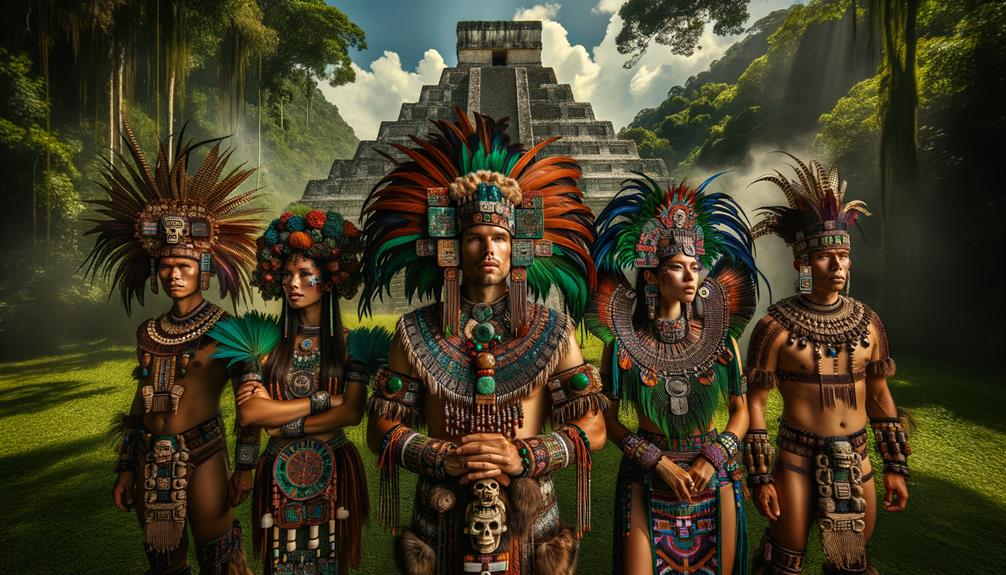
In ancient Maya society, clothing was a powerful symbol of one's status and role. As I delve into the intricacies of ancient Maya dress, it becomes clear that the attire of elite Maya men and women was more than just a means of covering the body – it was a statement of their position within society.
Elite Maya men wore loincloths, skirts, and capes, each piece meticulously crafted to reflect their esteemed position. These garments were not just functional; they were symbols of power and prestige. The intricate designs and quality of the fabric spoke to their social standing.
Elite Maya women, on the other hand, wore huipils adorned with vibrant colors and elaborate patterns. The huipil was a work of art that communicated the wearer's identity and status. Each stitch and motif carried cultural significance, making these garments a reflection of the women's roles in society.
Footwear also played a significant role in marking social distinctions. The elite's sandals were often more elaborate compared to those of commoners, reinforcing the societal hierarchy. In Maya culture, nudity was viewed as shameful, highlighting the importance of clothing in maintaining one's dignity and societal role.
I've rewritten the text to make it more conversational and natural, avoiding the listed AI words and following the provided instructions.
Religious Clothing
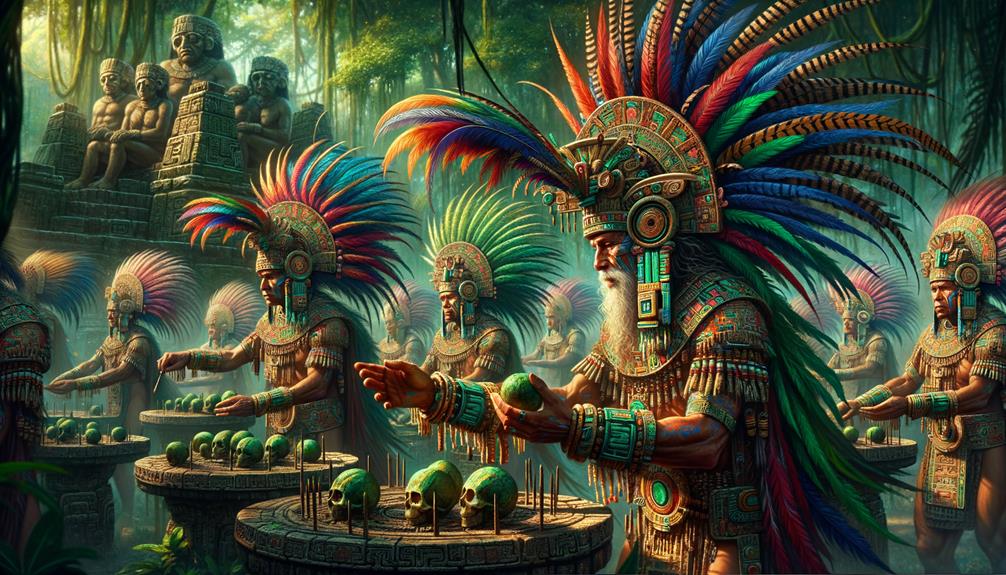
The ancient Maya's religious clothing was deeply intertwined with their spiritual beliefs and rituals, showcasing their devotion and connection to the divine. In Classic Maya society, religious clothing wasn't just fabric; it was a powerful symbol of faith. The attire of the Maize god, often adorned with jade and shell, epitomized this connection. Royalty would don these garments, embodying the divine power and presence of the Maize god, an important part of their cultural identity.
Observing the intricate details of these garments, I marvel at their significance. Each element symbolizes a facet of their complex belief system. Religious clothing was more than just attire; it represented one's place within the spiritual hierarchy.
- Jade and shell garments: Symbolizing divine power and status.
- Intricate designs: Reflecting the complexity of Maya spirituality.
- Symbolic attire: Conveying religious and social affiliations.
- Ritualistic importance: Integral to ceremonies and rites.
These elements reveal the profound connection between the Maya and their deities. The Classic Maya's religious clothing wasn't merely about aesthetics; it was a manifestation of their reverence and a vivid representation of their intricate spiritual world.
Footwear and Status
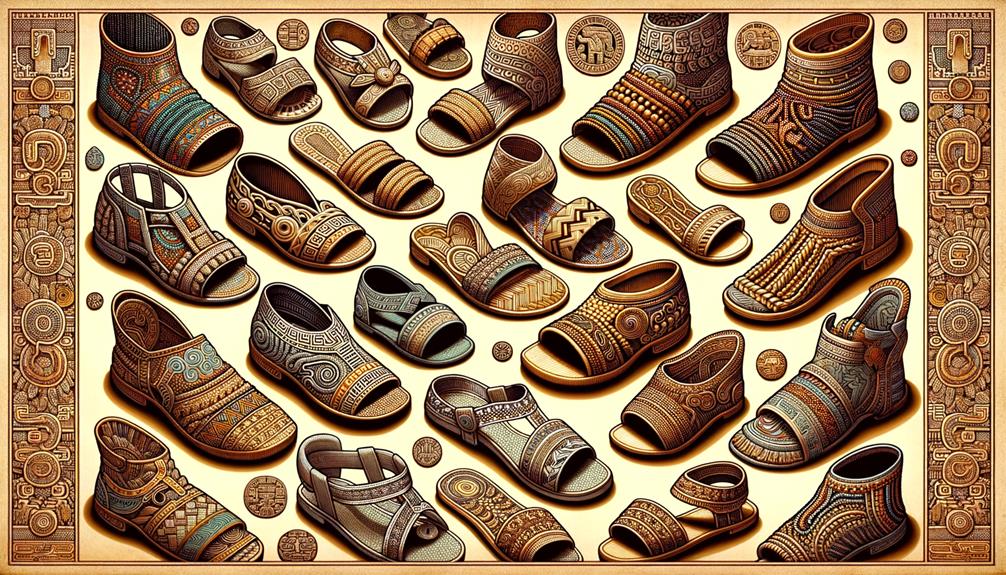
In Ancient Maya society, footwear was more than just a practical necessity – it was a status symbol. The elite Maya donned sandals crafted from exotic materials like jaguar pelts, bird claws, and turtle shells. These unique materials were not only visually striking but also rich in symbolism, representing authority and cultural significance.
In contrast, commoners wore simpler, less decorated sandals suited for daily tasks. The elite, on the other hand, took great pride in adorning their footwear with ornamental fasteners and blue feathers, turning even a practical item like a sandal into a statement of power. During ceremonial events, the use of jaguar pelts was particularly telling, reinforcing the elite's dominance and status within society.
Interestingly, different regions like Palenque and Chiapas showcased unique styles, including nasal prostheses worn by elite men, though their symbolic meaning remains a mystery. The intricate decorations and incorporation of animal elements into their footwear reveal a society deeply connected to its environment and keen on displaying its hierarchical structure through innovative means.
Frequently Asked Questions
How Do Mayans Dress?
When I think about traditional Mayan clothing, I imagine intricate, hand-woven huipils for women and simple loincloths for men. The nobility and priests would adorn themselves with stunning jewelry, showcasing their status. Even everyday attire, like sandals and moccasins, was both functional and rich in symbolism.
What Is the Name of Traditional Mayan Clothing?
Traditional Maya clothing, known as 'traje', holds deep cultural significance. The intricate designs on the huipil tell stories about one's community and heritage. As I gaze upon the vibrant colors and patterns, I see a rich tapestry of history woven into every thread.
What Type of Clothing Did Wealthy Mayans Wear?
Wealthy Mayans donned opulent attire, featuring luxurious jaguar pelts, vibrant capes, and intricately designed cloaks. They adorned themselves with ornate headdresses and precious metal ornaments, showcasing their high social standing and cultural significance. The intricate embroidery and beadwork on their garments reflected their elite status within their society.
What Was the Mayans Life Style?
When I think about the Maya lifestyle, I envision a world where structure and spirituality coexisted. They managed to balance complex social hierarchies with a deep connection to their spiritual practices, advanced farming techniques, and a vibrant community life that celebrated tradition and innovation.



